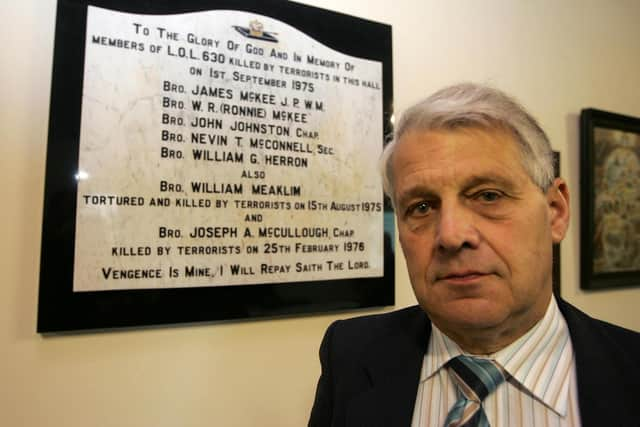Mystery over IRA suspect’s DNA from Orange hall massacre at Tullyvallen
and live on Freeview channel 276
Berry Reaney was a member of Tullyvallen Orange lodge in south Armagh in 1975 when the IRA burst in and opened fire on a lodge meeting. Four men were killed while a fifth later died from his injuries. He was shot in the arm.
He is part of a team that is bringing Orange banners which depict murdered members from across NI to display them at Brownlow House in Lurgan as part of Orange Victims Day from 1-3 September. In total 339 Orangemen and one Orange woman were murdered during the Troubles.
Advertisement
Hide AdAdvertisement
Hide AdThe legacy inquest into the 1976 Kingsmills Massacre in south Armagh found that the same IRA weapons were used at both Tullyvallen and Kingsmills.


In 2017 the Kingsmills inquest heard how a cap left behind by an IRA man at Tullyvallen had been discovered in archives - and contained two hairs. DNA tests were carried out and a report was provided to the coroner, however there is no evidence the contents were ever made public.
The News Letter has now gone back to the Coroner to ask how the matter was progressed. The Legacy Inquest Unit responded that in October 2017 all Kingsmills relatives were informed that the Coroner had received the report but that it was “not potentially relevant” to Kingmills.
So the News Letter asked the PSNI if it had progressed the matter. A PSNI spokeswoman responded: “Following DNA testing of the hair no evidential opportunities capable of progressing the investigation were identified.”
Advertisement
Hide AdAdvertisement
Hide AdThe News Letter asked if it would be possible to talk to a detective in more depth about the matter but the police declined. It said: “A review of this case was completed by the Historical Enquiries Team (HET) and, while it remains open and will be revisited should any new credible line of enquiry be identified, it is not under active investigation and therefore we would not be in a position to offer up anyone to talk about the case.”
However the News Letter pointed out that the cap and hair emerged some three years after the HET folded. This paper asked if the obstacle to any progress is the fact that the authorities do not hold DNA samples for the known IRA suspects? The PSNI has yet to respond.
After consulting with families of several Tullyvallen victims, Mr Reaney said that so far as he was aware, they had not been contacted by police about the cap, hairs, or DNA.
“Two members of HET interviewed some of us way back when it was set up and took statements. That was all we ever heard about it,” he said.
Advertisement
Hide AdAdvertisement
Hide AdHe added: “In one way I am surprised and in another I am not. When you look at the way the Kingsmills inquest has been going and the promises that were made to the families between the police and governments on both sides of the border, I don’t think they intend telling us anything.”
Kenny Donaldson, Director of Services with victims group the South East Fermanagh Foundation. said: “The fact that we have not been updated on what has become of DNA evidence acquired five years ago is shocking. The families of both atrocities have been treated shamefully and often been kept in the dark. The PSNI and Coroners Office have questions to answer in coming days.”
READ MORE: